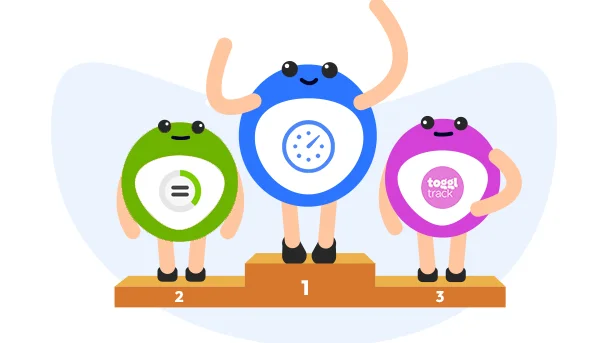
Whether you are looking to track your productivity hours or spend less time on your phone scrolling through social media, the best time tracking apps can help you develop better working habits. Now that most businesses function remotely, time tracking apps are also essential for staying on top of assignments and working on a schedule.
If you’re looking for the best time tracking apps on the market, this guide will tell you everything you need to know about how to use one and how they can help your business grow.
A time tracking app records your working hours and how much time you spend working on a particular task. Some time trackers come equipped with advanced features like planning for an hourly lunch break, pricing your work hours, and producing analytics.
As its name suggests, a time management app can provide insights into what tasks take up the most time throughout your workday. It can also offer other benefits like:
Creating task analytics: With a productivity app, you can determine how long it takes to complete a particular task and whether you need to reallocate more resources to increase productivity.
A reliable employee time tracking app should help you make smarter business decisions depending on how you spend your time. To help you achieve this, it should include the following basic time tracking features:
Real-time tracking: Most time tracking software will launch a running clock every time you start a task. Afterward, you can view this data in various formats to measure productivity and increase profitability.
Reporting features: If you want to measure performance, you’ll have to take a closer look at active employee hours and how long it takes to complete a specific task. This data should be available in easy-to-read formats like graphs or charts.
Third-party integrations: An employee time tracking app should make your business operations easier, so you’ll want to choose one that can integrate with your existing project management software.
Cross-device syncing: With a mobile time tracking app, you won’t have to always be at your desk to know how your employees are spending their time. Having desktop and mobile-compatible software also provides flexibility when you are out of the office.
Payroll management: Time clock apps with a payroll management system can help you save time calculating billable hours manually and avoid the chances of human error.
In most cases, startups and small businesses won’t require overly complex project management features. If you are investing in software for less than 100 employees, you’ll want to prioritize features like:
Billable hours tracking
Project cost calculations
Customized growth reports
You can easily pick the right time tracking software for your small business in these three simple steps:
Pick the features you need: Other than time tracking, consider whether you’ll benefit from additional features like data analysis, invoicing, and project tracking. Outside of these features, you’ll also want to consider what app is the best value for money, easy to use, and provides reliable customer support.
Shortlist your top picks: Now that you know what your business needs in an employee time tracking app, it’s time to shortlist your favorites. From there, you’ll want to consider which software better suits your needs. Think about your budget and scalability.
Go on a free trial: If you’re not ready to invest, sign up for a free trial. Remember that no two free trials are identical – some provide unlimited access to all their features while others may not.
What integrations are considered relevant will ultimately depend on your business goals. If you need to track time for an entire team, it might pay off to invest in something that integrates with project management software. If you’re using time tracking tools to simplify your scheduling process, pick one that integrates with calendar apps like Google Calendar.
Historically, the most popular time-tracking integrations include Slack, Asana, QuickBooks, and Trello.
20 Million+ Ready Automations
For 750+ Apps
Here are the top nine softwares we recommend for a time tracking solution.
Toggl is one of the best time tracking tools for businesses on a budget. Its generous free tier provides unbeatable automation and is also available as a browser extension for Android and iOS users. You can also automate tasks on Toggl using Integrately.
Browser extensions: Automatically keep time when you open your browser. If you are using Toggl as a manual extension, activate its desktop pop-up feature to remind you to start the clock as soon as you open your browser.
Pomodoro setting: Increase productivity by working for a set amount of time and taking scheduled breaks in between.
Device syncing: Do you need to run a sudden work-related errand in the middle of the day? Don’t worry – Toggl can automatically sync timekeeping onto your mobile device.
Limited project management tools: While Toggl works perfectly for automatic time tracking, it doesn’t have many features outside of that. For instance, it does not include invoicing or scheduling.
Pricey paid plans: Despite its lack of project management features, Toggl’s paid plans are costlier than most other software.
App stuffing: Unfortunately, some users claim that Toggl lags the more time entries you add to your account.
Toggl is free for up to five users. A Starter plan costs $9/month, billed annually.
Click here to try Toggl today!
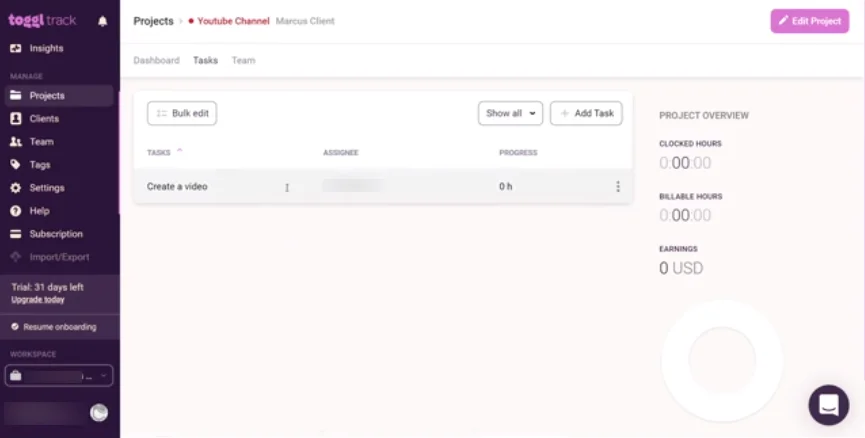
Apploye is a comprehensive workforce management platform that goes beyond basic time tracking.
At just $2.50/user/month, it offers an impressive suite of features including shift scheduling, leave management, client invoicing, payroll automation, and optional employee monitoring.
Built for remote teams and growing businesses, Apploye helps manage the entire employee lifecycle from attendance to payment.
All-in-one workforce solution: Beyond time tracking, includes shift scheduling, leave management, payroll automation, client invoicing, and team organization – essentially replacing multiple tools.
Productivity-focused features: Built-in Pomodoro timer, idle time detection, and activity tracking help teams stay focused and accountable.
Exceptional value: Starting at $2.50/user/month with features that competitors charge $10-30/user/month for, including multi-company support and unlimited projects.
Limited integrations: Only connects with five platforms.
GPS tracking requires a separate purchase: While advertised as included in the Elite plan, GPS tracking actually requires FieldServicely (a separate product from the same company) at additional cost.
Payroll is documentation-only: Despite being called a “payroll solution,” you can’t actually make payments through Apploye – it only records payment amounts for reference
Apploye offers two plans:
Both plans include a 10-day free trial.
Click here to try Apploye today!

If you’re looking for a simple time tracking tool for your remote team or mid-sized agency, Everhour is for you. Its task management features allow users to create time estimates for individual assignments. It also has team-specific features like scheduling.
Automatic reminders: Remind your employees to track their working hours by setting up automatic notifications.
Time estimates: Create billable and non-billable time estimates for ongoing projects and reimburse employees within the app.
Rich additional features: If you don’t yet have a project management tool, Everhour is an excellent place to start. Other than time tracking, it also has budgeting and communication capabilities.
Tricky integrations: While Everhour is compatible with many third-party tools, integrating it can take a lot of rework and trial and error.
Steep learning curve: Because of its long list of features, Everhour might take some getting used to.
Limited mobile app: For some time, Everhour didn’t have a mobile app. It does now, but the existing app has minimal functionality.
Everhour has a free plan and a premium plan at $10/month.
Click here to try Everhour today!

For business owners who rely heavily on their calendars, HourStack is an excellent tool for visualizing work hours. Its scheduling features are perfect for shift and contractual workers.
Workload overview: Take note of who is under and overworked by comparing scheduled and logged times.
Stunning interface: Many users praise HourStack for its clean and easy-to-read interface. Get a clear overview of your day in calendar view.
Seamless integrations: Are you already using an existing task app? Simply drag tasks from other apps into HourStack to track them.
Basic reporting: Unfortunately, HourStack does not provide detailed reporting. Expect to see very bare-boned insights on your week.
No pricing features: Without billable projects or hourly rates, budgeting with HourStack poses a challenge.
Not ideal for bigger teams: HourStack may not be appropriate for larger businesses because it lacks enterprise tools.
HourStack has two paid plans: a Personal plan at $10/month and a Team plan at $15/month.
Click here to try HourStack today!
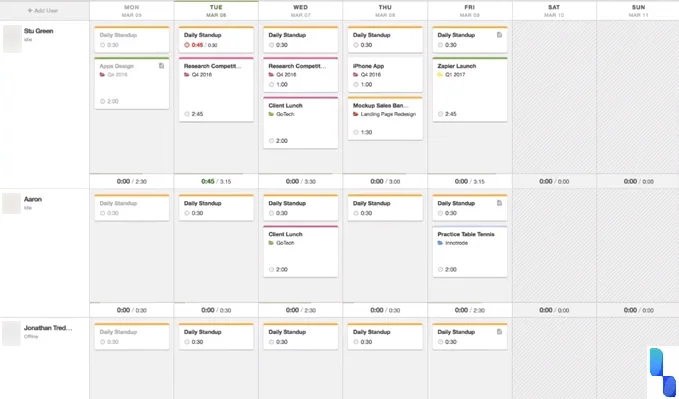
Are you looking for software with flexible invoicing tools? If so, Harvest has an invoicing module that links up to payment portals like Stripe and PayPal. By taking online payments directly from the app, you’ll no longer have to be worried about chasing down clients. You can even pick up the pace by automating tasks through Integrately.
Invoice reminders: If you have trouble remembering to submit your timesheets, set up automatic notifications that remind you to bill your clients.
Offline tracking: Are you working on an unstable internet connection? You can still keep your time offline and sync it to your account later in the day.
Harvest Forecast: For business owners who want to automate schedules, try out Harvest’s employee tracking features!
Lack of detailed reporting: Unfortunately, you’ll have to miss out on utilization reports and unsubmitted timesheet tracking with Harvest.
No audit trails: Despite its robust collaboration features, there is no way to keep track of who is making edits on your timesheets.
No timestamps: Managers can’t track when timesheets are submitted for approval.
Harvest offers a free plan plus a paid plan at $12/month.
Click here to try Harvest today!
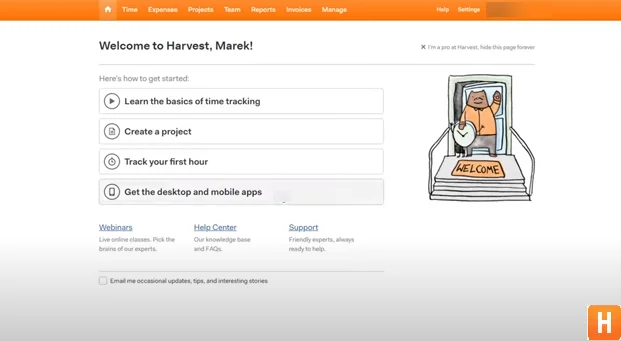
RescueTime can automatically track your productivity hours while blocking specific websites throughout the workday – especially helpful if you get easily distracted. It functions in the background and keeps track of your computer usage. It can even notify you when you’re spending too much idle time or working on too many things at once.
FocusTime: Block distracting websites while working. Schedule recurring times for the week.
Productivity reports: Get a daily productivity score by tagging specific websites as “distractive” or productive. Get a higher score by avoiding distractive sites and spending time on productive ones.
Goal setting: RescueTime is an excellent tool for personal productivity because of its goal-setting features. Note how many tasks you want to complete in a day or week and hold yourself accountable!
Complex setup: Setting up your productivity scoring system involves a bit of a learning curve. For instance, you’ll have to tag which websites you consider productive and which aren’t. You’ll also have to categorize specific actions such as staying idle or typing.
No exporting: If you want to save your data to your device, you’re out of luck.
Manual invoicing: Unfortunately, you’ll have to create manual invoices every time you bill your hours.
You can opt for either RescueTime’s free plan or the paid plan at $6/month, billed annually.
Click here to try RescueTime today!

Timeular is a time tracker unlike any other in that it combines digital tracking with a physical device. It’s an eight-sided die that you can flip on its side to start tracking a particular task or when you take a break. The Timeular die connects to your laptop or mobile device via Bluetooth.
Ideal for desk work: If you’re someone who spends eight hours behind a desk, this manual device can make keeping track of your productivity hours more enjoyable. Not to mention, manually flipping it can help you become more mindful throughout the workday.
Comprehensive analytics: Timeular provides detailed reports that you can export as a CSV, XLSX, or PDF file.
Visually appealing: Not only is the Timeular die itself beautifully designed, but its desktop app is also stunning and intuitive.
No standalone app: Unfortunately, if you forget your Timeular die at home, there’s no use trying to fiddle with the app on its own. The only way to track your time is to flip the die.
No budget setting: Despite its steep price, the Timeular software itself is relatively bare-boned. For instance, you’re not going to get any budget-setting features with it.
The monthly and annual plans cost $99 for the die plus $9/month and $7/month respectively. If you want a lifetime plan, it costs $49 for the die plus a $299 one-time fee.
Click here to try Timeular today!
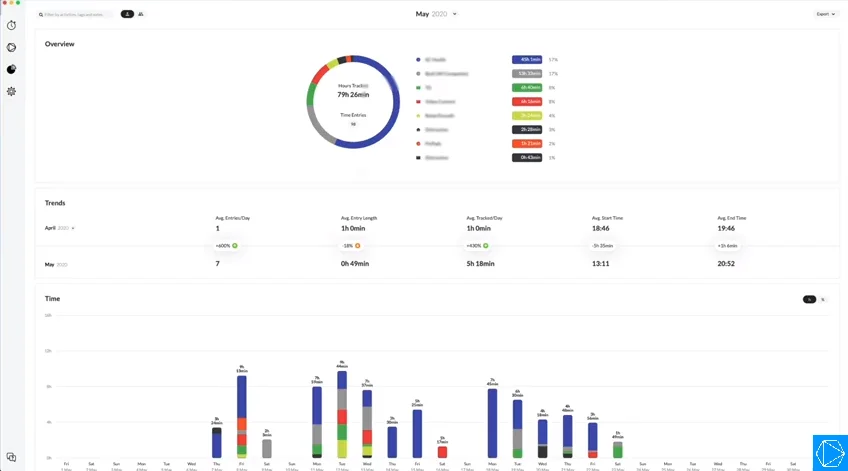
For freelancers and small business owners looking for a smart time tracker, Timeneye is for you. This simple time tracker can suggest upcoming schedules and tell you how you spend your time based on previous logs. Its reporting and projecting tools are highly detailed, perfect for when you need to scale your business up.
Smart tracking: Get task and scheduling suggestions based on how you spend your time every day.
Functions on multiple devices: Track your time on your desktop and mobile device, or use Timeneye as a Google Chrome extension.
Progress status tab: Keep track of how your projects are going with the progress status tab, displayed neatly on top of your browser beside your time tracker and ongoing budget.
Overstuffed with features: Timeneye might offer too many options for single users. Chances are you’re not going to need its highly detailed reports and hyper-complex projecting tools.
No offline mode: If you’re on the go and without data, you won’t be able to access Timeneye’s mobile app.
No start and stop recording: There’s no way to note when you step away from a project unless you track these times manually.
Timeneye’s basic plan is free with unlimited projects. The Starter plan costs $7/month.
More than just a standalone time tracking solution, Hubstaff is also an excellent tool for enhancing employee productivity. It is equipped with rich features like mobile GPS tracking, keystroke recording, and automatic screenshots. If you run a large enterprise, Hubstaff is a perfect choice.
Map functions: Keep an eye on your field workers through real-time GPS tracking. Pinpoint optimal routes before dispatching workers.
QuickBooks Online integration: Get total control over your payroll with a free Quickbooks Time integration.
Step-by-step guides: If you’re new to Hubstaff and are overwhelmed by its features, you can get step-by-step instructions for each function. Click through key functions like “track profitability,” “make payroll easy,” and “know what my team is working on.”
Expensive integrations: While Hubstaff’s free plan comes with some integrations, you’ll have to upgrade to a basic plan to access all 40. If you want unlimited integrations, you’ll have to upgrade to a premium plan.
No shift planning: Despite its superior employee productivity features, Hubstaff has no option to add future times. Users can only request to edit previously submitted timesheets manually.
Stopwatch requires a second app: While you can access the stopwatch feature on your mobile device, you’ll need to download a second app to use it on your desktop.
Hubstaff has a free plan, a Starter plan ($7/month), and a Pro plan ($10/month). Custom Enterprise plan pricing is available upon request.
Click here to try Hubstaff today!
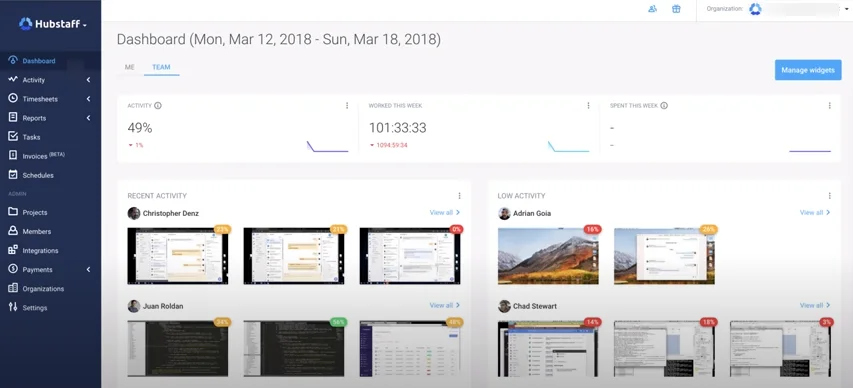
If you’re already using QuickBooks as accounting software, there’s no better way to integrate your time tracking than with QuickBooks Time. On top of its basic scheduling, Quickbooks Time also provides premium features like job costing, weekly reports, and a dedicated customer service team. It is ideal for teams looking for something responsive, intuitive, and easy to use.
Multiple clock-out options: If your employees use many different devices, they can clock out of work from multiple platforms like QuickBooks Time Kiosk, the QuickBooks Time mobile app, or from their desktop dashboard.
GPS tracking: Keep an eye on your on-the-go employees and set geofencing boundaries.
Mileage tracking: If you run an active fleet, mileage tracking can help you stay on top of fleet expenses and determine more optimal routes.
Pricey: Compared to other time trackers, QuickBooks Time is a little pricey, with Premium plans costing $20/month and Elite plans costing $40/month.
No free version: If you’re not sure QuickBooks Time is for you, there is, unfortunately, no way to test it out for free.
Limited customer service availability: While its customer service team proves elite, they are only available on weekdays and for a limited time.
The Premium plan costs $20/month, while the Elite plan costs $40/month.

What time tracker works best will ultimately depend on your business goals and company size. For instance, if you’re looking for a standalone time tracking solution that notes work hours, apps like Clockify or Toggl might best suit your needs.
If you want to track time to improve your personal productivity, consider using an app like RescueTime, which intuitively studies your working habits. On the other hand, you can try something new with a physical time tracker like Timeular.
The best way to decide what time tracker is best for you is to consider factors like:
How many people are on your team
Whether you need additional features like payroll, invoicing, GPS, and reporting capabilities
Whether you run a startup or a large enterprise
Your current budget
If your team is falling behind because of poor time management, the best time tracking apps can help get you back on your feet. This unique software doesn’t just help you track time – they also pinpoint areas of improvement, automate repetitive administrative tasks, and make smart suggestions depending on how you spend your time.
Do you want to make your day even more productive? Integrately can automate actions for over 600 apps and make your workday feel like a breeze.
The cost you pay for the time tracking software will depend on the size of your business and how you intend to use the software. Therefore, the answer will ultimately vary. However, factors that might affect how much you end up paying for a subscription include:
How many employees you have on your team
Whether you require multiple integrations
How much of your monthly budget you can allocate to new software
Whether you prefer to pay for a monthly subscription, a yearly subscription, or a one-time sum
What type of reporting capabilities and other features you might need
Whether your team works remotely or on-site